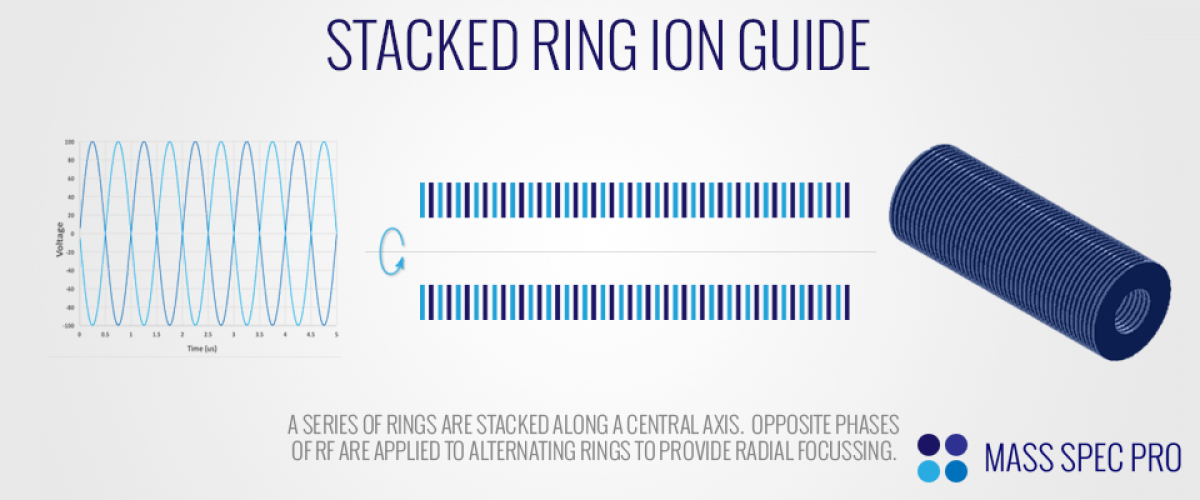In the late 1960's a team of researchers developed a novel concept for focussing and transmitting ion beams, which has since been termed the "stacked ring ion guide" (SRIG). Mechanically speaking, a SRIG is comprised of numerous metal rings which are stacked coaxially along a central line, with small gaps in between each ring. In order to transmit ions through the SRIG, the electric fields should both (1) keep the ions off of the guide's walls and (2) propel the ions axially toward the guide's exit.
Radial Focusing
In order to achieve radial focusing, the rings of a SRIG are divided into two pairs, alternating back and forth down the length of the guide. Typically, one set of plates has an RF waveform applied to it, while the second set of plates has a waveform of the same frequency applied 180 degrees out of phase to the first set.

The mechanism for radial focusing via RF waveforms is akin to that of multipole ions guides. If the plates are relatively close together, their equal and opposite RF waveforms cancel each other out at any significant distance away from the plates. As such, ions don't feel much of a radial force unless they are near the walls. However, as they approach the walls, they begin to feel the localized effects of the individual plates. As an ion approaches a plate, it will experience an oscillating field. As the RF goes to its negative swing, the ion will be accelerated out toward the ring. However, as the ion is beginning to move outward, the RF will reverse phase and turn positive. During this positive phase of the RF, the ion is accelerated back toward the center, with a force that is even stronger than before since it is closer to the plate. The fact that the force pushing the ion back to the center is stronger than the force pulling it outward results in the net effect of pushing the ion away from the plate. If we look past the nuances of what happens in each specific RF cycle, but instead look at a longer time scale, then the rapidly oscillating RF voltages have a time-average "effective potential" (aka "pseudopotential") that pushes the ions back toward the center of the guide. It should be noted that the effective potential is quite flat across the bulk of the SRIG's. As such, it is difficult for a SRIG to focus the ion beam down to a small radius. This makes it a non-ideal solution for focussing ions through small conductance limits that separate vacuum stages of differentially pumped vacuum chambers.
Axial Propulsion
Although the opposite phases of RF provide a mechanism for confining the ions radially, there is always a need to manipulate the ion trajectories in the axial direction as well. Towards that end, SRIGs allow different DC voltages to be applied to the various rings. Most commonly, a DC gradient is applied to the rings, with the frontmost ring being at a more positive voltage than the backmost ring, and a linear drop in voltage for the rings in between them. Such a DC gradient provides a "downhill" electric field for positive ions, such that they're continually pushed toward the rings with lower voltages. The combination of radial RF focusing and the DC axial pushing provides a quite effective tool for transmitting an ion beam.
Usage
The SRIG is commonly used as a "drift tube" in ion mobility instruments. The wide, flat effective potential in the radial direction combined with a DC gradient in the axial direction allow the ions to drift relatively unhindered down the length of the guide. The SRIG has also been used as a holding chamber of sorts for monitoring ion-molecule reactions, iterrogating ions with lasers, etc. Variants of the SRIG, especially the "ion funnel" have seen wide usage in recent years.
